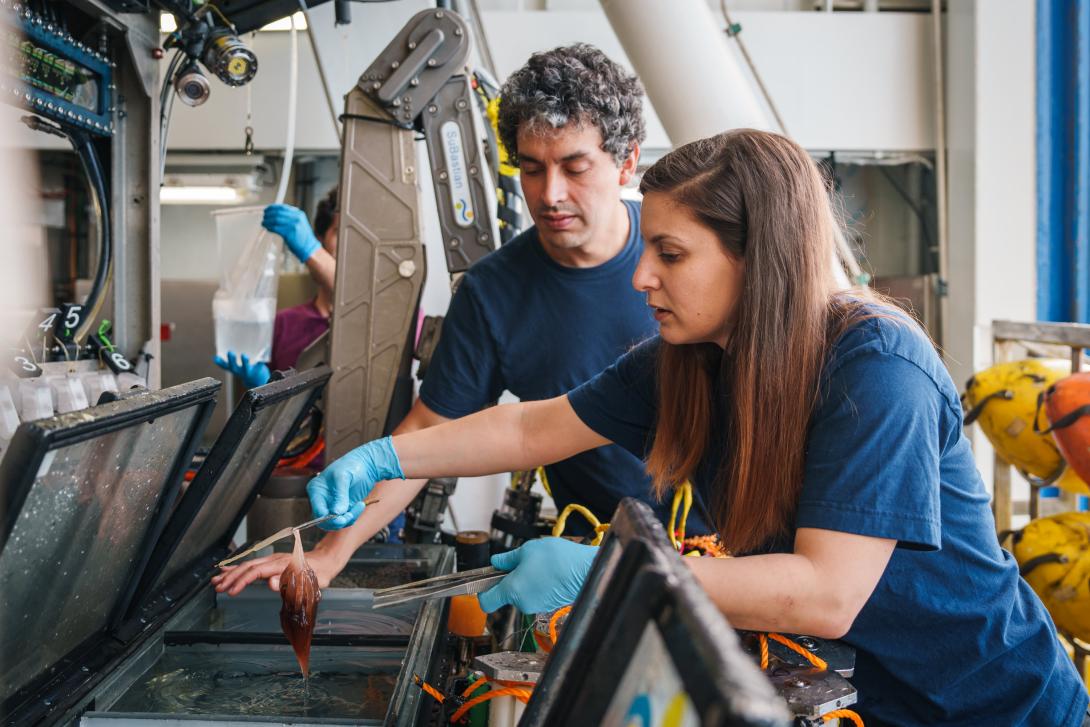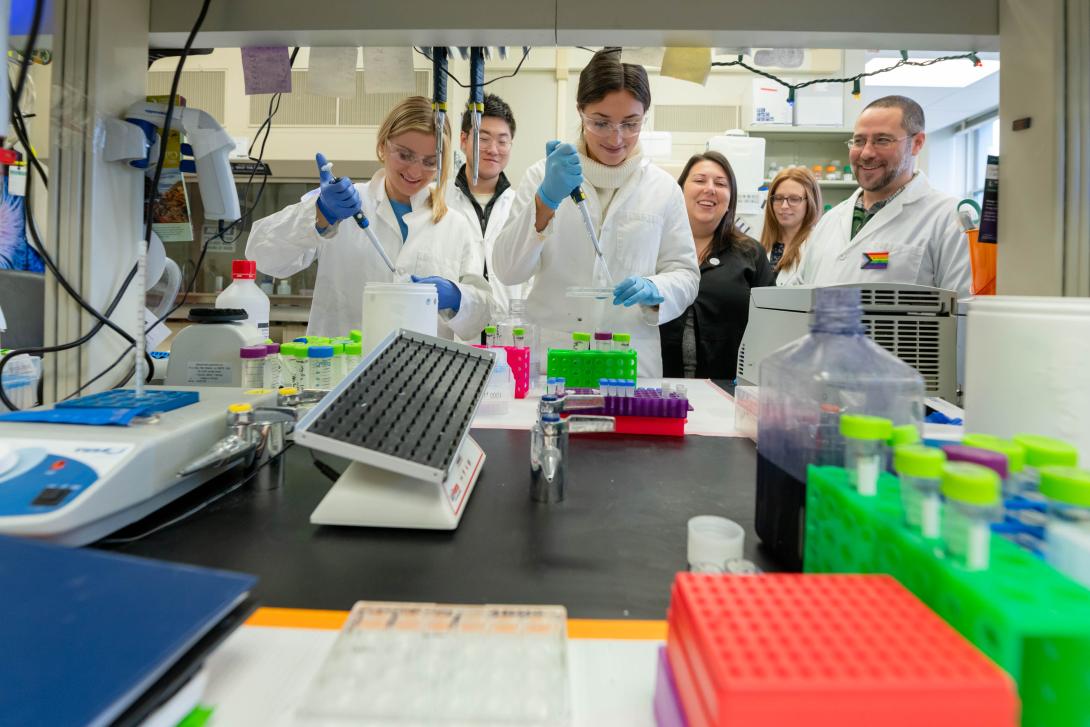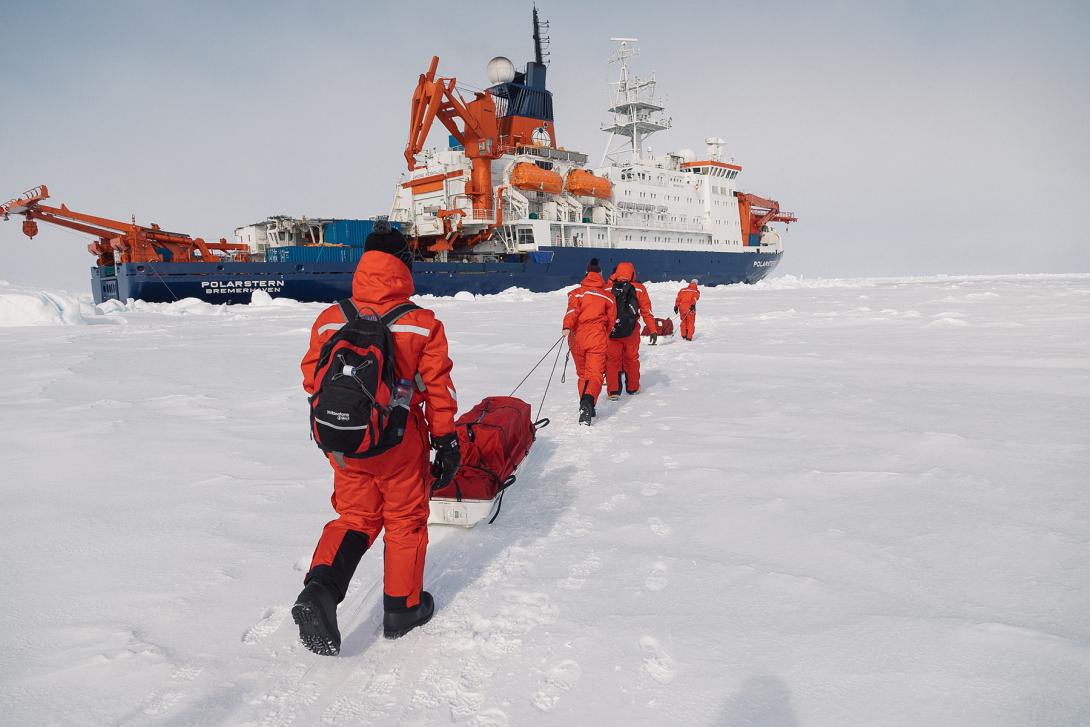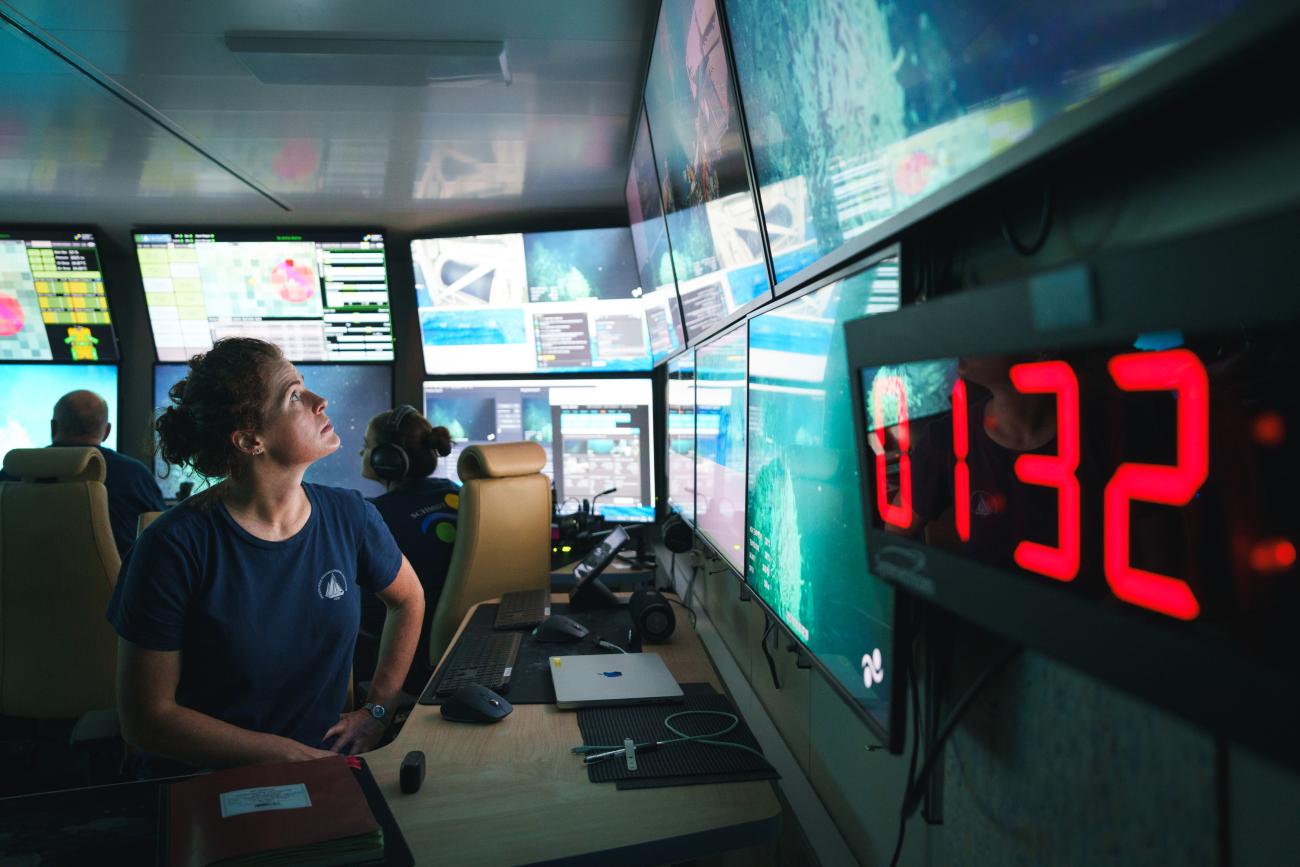Lehigh’s Deep Dive into Ocean Science
A new interdisciplinary research center explores one of the most vital resources on Earth—the ocean
The oceans are one of the biggest and most important resources on Earth. They cover more than 70 percent of the planet’s surface and are connected to vital weather and climatic patterns, a plethora of food sources and a wealth of economic activity.
“What happens in the oceans impacts the entire planet,” says Lehigh biologist Michael Layden.
This is why Lehigh’s College of Arts and Sciences just launched Lehigh Oceans Research Center, created to focus on marine science and the most pressing questions facing the Earth’s oceans. Lehigh Oceans is both an acknowledgement of the strength of ocean research at Lehigh and a place to go deeper.
“You don’t need to have access to a coastline to have a vibrant research program in ocean science,” says Jill McDermott, associate professor of Earth and environmental sciences, who is a geochemist and the inaugural director of the center. “The researchers associated with Lehigh Oceans are successful as individuals in our respective fields, and we hope if we combine our successes together, we’ll have even more scientific impact as a center.”
The field of ocean science has risen in global importance in recent years. There’s been a growing recognition of the urgent need to address the oceans’ health and to probe how the oceans are responding to climate change, pollution, acidification and rising sea levels. In 2021, the United Nations launched the UN Decade of Ocean Science to promote ocean science that will reverse the decline of oceans and help sustain marine ecosystems.
“Oceans are critical for the health of our planet,” says Santiago Herrera, assistant professor of biological sciences. “They play a fundamental role in regulating the Earth’s climate, feeding our population, producing goods and services, contributing to novel medications and providing energy alternatives to fossil fuels.”
The four Lehigh researchers affiliated with the center have already landed millions of dollars in research funding for their work studying ocean systems and the life within them. Lehigh Oceans will provide an official home to expand upon this work, attract new funding sources and create a vibrant community of interdisciplinary researchers that can include experts from all of Lehigh’s colleges.
Marine science is an inherently collaborative field, says McDermott, as many research questions naturally draw on different disciplines. Even the logistics of ocean research invite collaboration, as research groups often team up on field expeditions out to sea.
“Many research projects require cross-disciplinary partnerships because the ocean is a complex system,” says Herrera, adding that he’s worked with geologists, engineers and physicists on various research projects and is a frequent collaborator with McDermott, among others at Lehigh.
“You need multiple insights to be able to study a system as complex as the oceans,” says microbial ecologist and biogeochemist John Paul Balmonte, assistant professor of Earth and environmental sciences. He remembers that the core classes for his graduate work spoke to the interdisciplinary nature of the field, as they included physical, chemical, geological and biological oceanography.
The researchers hope to foster an environment at Lehigh Oceans that will generate even more interdisciplinary collaboration, along with a culture of informal conversation and ideation for researchers at Lehigh, which can stimulate new research and dialogue across ocean science.
“When you convene a bunch of people with fairly diverse expertise, it naturally leads to more innovation,” says Balmonte.
Lehigh Oceans will serve as an instrument to attract early career researchers and students to Lehigh, as it signals that Lehigh is an institution taking ocean science seriously. It will also offer meaningful research opportunities and financial support for early career researchers and students, including funding for seed proposals that can grow into bigger research projects. In addition, it will host regional and international symposia to foster conversations and collaboration with researchers across the globe.
“If you build it, they will come,” says Layden, associate professor of biological sciences. “Lehigh Oceans will let people know that we have a critical mass of researchers doing interesting and collaborative work in marine science.”
Here’s a closer look at what the researchers affiliated with Lehigh Oceans are doing in ocean science.
Biodiversity in the Deep Sea
When the Deepwater Horizon oil spill dumped four million barrels of oil into the Gulf of Mexico in 2010, it raised many critical questions about the environmental impact of the spill.
Santiago Herrera received support from the National Oceanic and Atmospheric Administration RESTORE Science Program to bring his research expertise to the Gulf to help investigate the ecological toll of the spill and to help guide restoration efforts. He specifically focuses on deep-sea corals, which provide vital habitat for marine life, including abundant invertebrate and fish communities, many of which are key commercial species, like crab and shrimp.
Herrera studies the biodiversity surrounding the deepwater corals and the processes that limit their reproduction, which can help inform resource management in the waters affected by the Deepwater Horizon oil spill.
“We’re working to better understand these ecosystems to inform resource management, as well as understand the basic mechanisms that shape biodiversity in the deep ocean,” he says.
Herrera broadly specializes in understanding biodiversity in the interior of the oceans and the deep sea, which is a challenging environment for life to survive since food and light are scarce and living things have to endure extreme pressure in the deepest water.
“We have very poor knowledge about what biodiversity patterns exist in the deep sea,” he says. “And the main reason for that is because humans haven’t explored it yet.”
In other ecosystems, it’s easier to see and understand variations in biodiversity, he explains—for example, if you compare the different animals that reside in Africa to North America or the higher biodiversity of tropical areas to the lower levels in polar regions. It’s not as easy to just look into the darkest corners of the deep ocean and see what’s happening with biodiversity.
“But, we’ve found a surprising amount of diversity in the deep ocean,” says Herrera. “Every time we go out on an expedition, we discover a new species.

“So now, why is there such high diversity in the deep sea, and what processes contribute to its biodiversity?” he asks.
Herrera’s research aims to answer these questions by examining factors like the role of depth, pressure and temperature as drivers of diversification. He also wants to better understand how biodiversity is affected by the borderless nature of the ocean. Life in the ocean is interconnected, he explains, and he collaborates with other researchers to probe how things like currents and the movement of the ocean affect the different species that dwell in the deep sea.
“If we want to preserve a species of coral that holds ecological importance, we have to understand how its populations are interconnected because we need to think of it as a network rather than just a single box around one place the species lives,” he explains. “We need to think about how organisms move and interact with others, so we can maintain their ecological connectivity.”
His research holds huge implications for things like the management of marine resources and protected areas and the restoration of deep-sea corals in places like the Gulf of Mexico.
Herrera is currently discussing additional ideas for research projects related to the Deepwater Horizon oil spill with Layden, as they’re interested in examining the reproductive traits of deep-sea coral, so they can better understand what conditions will help it recover in an environment like the Gulf of Mexico.
Reproduction and Regeneration in the Ocean
Coral reefs are a vital part of the marine ecosystem and provide critical habitat for many living organisms—both in the deep sea and closer to the surface of the water.
Reefs are living things themselves, comprised of sea anemones and corals, and are vulnerable to changing ocean temperatures and acidification. When a reef dies, it can have a huge ripple effect across the ecosystem, wiping out the populations that depend on it for habitat, including sea turtles and agriculturally important juvenile fish.
Michael Layden’s lab is interested in investigating how corals and sea anemones reproduce, as it’s a key part of a reef’s ability to repopulate. They’re also interested in how spawning is affected by things like a growing amount of human light pollution.
“It’s a very simple biological question that has a big impact in the long run,” he says.
But, the reproduction of corals and sea anemones is a challenging matter to investigate because many corals only spawn once a year. So, Layden’s research team has found a way to model the biology of coral spawning in a closely related sea anemone that spawns well in culture. This allows Layden’s lab to test different theories throughout the year and hone in on the most strategic questions to target when they have the opportunity to visit wild populations during spawning season.
“This research helps us understand how their biology is being impacted by the changing world and the changing ocean,” he says.

His lab also studies the extensive regenerative abilities of sea anemones. His research aims to understand the mechanisms that drive regeneration of the nervous system and how they differ from those that generate the nervous system during development. The sea anemone Nematostella vectensis is an ideal model to conduct this work because the sea anemone genome is closely related to the human genome and it’s one of the few species where researchers can study both neural development and regeneration. The hope is that this research can lead to valuable insights about human biology, and additional funding from the National Institutes of Health supports work on the foundational science that fuels these questions.
“Understanding the similarities and differences between development and regeneration will provide critical clues necessary to better design regenerative therapies for biomedical applications,” says Layden. “The implications from our work will help forge a much better understanding about how you alter development to make regenerative neurogenesis successful. It’s really early in the field, so every breakthrough and piece of knowledge is critical.”
The Chemistry of Underwater Volcanos—and How Life Survives Without Sunlight
There’s no sunlight in the deep ocean, but there may be answers to some of the most fundamental questions about life on Earth—and beyond.
Jill McDermott is trying to find some of those answers by studying how life in the deep ocean is mediated by chemistry.
Life in the deep ocean is different from life on the surface. It can’t rely directly on photosynthesis to survive because no sunlight reaches the deep ocean.
“It’s the darkest dark you’ll ever see,” she says. “Because there’s no sunlight, the basis of the food web is microbes, and those microbes are directly reliant on chemical energy. They’re the building blocks of life. Studying the chemical makeup of these systems can help us understand how life survives without sunlight.”
McDermott investigates the fundamental geological and biological processes that sustain specific types of microbial life in the deep sea. She specifically looks at the interaction between seawater and volcanoes on the seafloor, which are known as hydrothermal systems, to uncover clues about how these ecosystems can exist in permanent darkness. Hydrothermal systems heat up the water and create a chemical-rich mineral soup that sustains life in the deep ocean.
Her research could shed light on the origins of life on Earth and provide clues about life on other planets. McDermott has received funding from National Aeronautics and Space Administration to study and apply her ideas to other water-rich environments in the solar system like the icy moons Enceladus and Europa.
“The better we understand Earth’s oceans, the more we can extend that to other places.”

She also aims to understand what creates chemical diversity and differences across hydrothermal systems. She investigates factors like temperature, depth, pressure and geology to probe these differences. She recently returned from an expedition that sailed west of the Galápagos Islands with members of the Herrera lab, where the pair are collaborating on research on how different types of volcanic systems affect the ecosystems surrounding hydrothermal vents in the eastern tropical Pacific.
“What we learn will be crucial in determining worldwide efforts to protect the essential resources our oceans provide,” she says.
How Organisms Are Responding to the Changing Ocean
John Paul Balmonte says he wears two hats in his lab. As a microbial ecologist, he investigates why different microorganisms live in certain parts of the ocean but not others—like the ocean’s surface but not the deep sea—and how they’ve adapted to the varying conditions associated with each place. He’s especially interested in asking these questions in underexplored areas, like the Arctic Ocean and deep maritime environments.
"We’re starting to get a lot more access to the Arctic Ocean as the sea ice melts,” he says. “And as technology improves to withstand pressure, we can obtain samples from the deepest parts of the ocean.”

When he’s focusing on the biogeochemistry side of his work, he’s interested in how life cycles through different environmental elements, like carbon or nitrogen.
“These elements are essential for life,” he explains. “I’m trying to understand how microorganisms are involved in processing these elements, so we can understand phenomena that’s happening naturally or as a function of various aspects of global climate change.”
He explains that much of the research across both microbial ecology and biogeochemistry is related to how organisms respond to the changing ocean. His work focuses on examining how microorganisms are responding to different parameters within the changing oceans, like increasing temperature, decreasing pH or emerging contaminants that flow from rivers to coastal oceans.
He points to sea ice as an example. When temperatures rise, sea ice melts, and it changes aspects of that part of the ocean. A thin layer of freshwater forms on the surface of the ocean, creating a density gradient and exposing the surface layer to sunlight. Balmonte studies how organisms respond to the changes in the environment and the production of biomass caused by more sunlight.
He also studies how changes on land are affecting the ocean—like the thawing of permafrost. This thawing can release organic carbon from the soil, which can turn into inorganic carbon or methane or can get flushed into the ocean.
“We have to understand how the ocean is responding to the changing climate, and to broad global change, because we as humans depend on it,” he says. “That’s why it’s so important for Lehigh Oceans to exist and support ocean research. Oceans are the lifeblood of our planet.”

